Yi Jin Jing (易筋经)
Introduction
Yi Jin Jing.  is a health and fitness exercise handed down from ancient China. In Chinese, Yi. means “change”, “Jin” means “tendons and sinews,” and “Jing.” means “methods.” This is a relatively intense form of exercise that aims at strengthening the muscles and tendons, thus promoting strength and flexibility, speed and stamina, and balance and coordination of the body. It pays great attention to the coordination of movement, respiration, and the mind so as to guarantee that Q. (vital energy) circulates freely and smoothly. As with most exercises, there is an enormous variety in form of Yi Jin Jing. the most popular being the “12 Postures of Changing Tendons,” devised by Pan Wei in 1858 in the Qing Dynasty (1644–1911).
is a health and fitness exercise handed down from ancient China. In Chinese, Yi. means “change”, “Jin” means “tendons and sinews,” and “Jing.” means “methods.” This is a relatively intense form of exercise that aims at strengthening the muscles and tendons, thus promoting strength and flexibility, speed and stamina, and balance and coordination of the body. It pays great attention to the coordination of movement, respiration, and the mind so as to guarantee that Q. (vital energy) circulates freely and smoothly. As with most exercises, there is an enormous variety in form of Yi Jin Jing. the most popular being the “12 Postures of Changing Tendons,” devised by Pan Wei in 1858 in the Qing Dynasty (1644–1911).
The origin of Yi Jin Jing. as an ancient Qigong. manual is attributed by Shaolin Kung Fu to Bodhidharma, though it has been doubted by some martial arts historians. According to some research, Yi Jin Jing. is attributed in legend to Bodhidharma (also called Da Mo or Tamo), who is supposed to have been in China during the early fifth century A.D. However, there are many other versions of how the Yi Jin Jing. was handed down through history. The most popular story about Bodhidharma relates that when he went to reside in the Shaolin Temple (built in 495 A.D.), he saw that the monks were weak and unhealthy. In order to strengthen them, he devised a system of exercises called Yi Jin Jing. Before his death, Bodhidharma gave his successor, Hui-neng, two sacred books, the Xisuijing. and the Yi Jin Jing. The Xisuijing. unfortunately, did not survive history, but the other did.
The traditional Yi Jin Jing. is closely related to and reflected in Traditional Chinese Medicine (TCM) theory, Yin and Yang, and the Five Elements (Metal, Wood, Water, Fire, and Earth) Theory in its movements and exercises to improve health.
Characteristics and Preparation
The basic purpose of Yi Jin Jing. is to turn frail, flaccid sinews and tendons into sturdy ones. The movements of Yi Jin Jing. are at once vigorous and gentle. Their performance calls for a unity of will and strength, i.e. using one’s will to direct the exertion of muscular strength. It is coordinated with breathing. Better muscles and tendons mean better health and shape, more resistance, flexibility, and endurance, and are obtained as follows:
- Postures influence the static and nervous structure of the body.
- Stretching muscles and sinews affects organs, joints, meridians, and Qi.
- Torsion affects metabolism and Jing. production.
- Relaxed, natural breathing produces more and better refined Qi.
- Active working provides balance and strength to the body and mind (brain, nervous system, and Spirit).
Power and endurance are of paramount importance if we look at becoming qualified in whatever practice we choose, such as Tuina, Taiji. or Martial Arts, or simply attaining better health and deeper wisdom. There is also an element of Yi Jin Jing. that is supple and flexible. Movements are energetic and intense, but a kind of peace resides at its core. Yi Jin Jing. in fact, unifies Y. (intention) with L. (strength), and consciousness (Yang) with muscular force (Yin). The mind is free from thought, having a correct and well-disposed attitude, and the breathing is harmonious. Internal and external movement must be coordinated, balancing movement with relaxation. Externally there must be fortification, while inside there must be purification. Thus, matter and Spirit are unified.
Some classic recurring points of Yi Jin Jing. can be described as follows:
- Most of the movements use open palms; fists are used only for stretching the tendons.
- The names of the exercises may change, but the basic idea of the movement typically remains the same.
- Movements are done standing, sometimes bending forward, but never lying or sitting.
- The eyes are always open, never closed.
- Movements are slow but full and tensed; the face and body show a relaxed attitude.
- The upper body (especially the shoulders) is actively engaged and moved in all directions.
- Dynamic tension rules the moves.
- All parts of the body work together.
- There are different ways of practicing the same Yi Jin Jing. form, according to the basic rules and depending on one’s body shape, the time of practice, and general health conditions.
The Five Rules of Yi Jin Jing. are:
(1)Quietnes. — like lake water holding the reflection of a full moon, a calm Spirit allows energy to move inside the body.
(2)Slownes. — in order to deeply flex the muscles, to obtain maximum extension, and to move Q. and Blood, slow movements are required.
(3)Extensio. — each movement must be brought to the maximum point possible.
(4)Paus. — efficacy comes through waiting and maintaining the tension for a longer time.
(5)Flexibilit. — the limbs and trunk must be extended so that Blood and energy can circulate, and thus we have flexibility.
Yi Jin Jing. should be practiced with a tranquil mind. The mind should follow the movements and should be coordinated with the circulation of Q. and the body movements. Gentle and easy breathing, without any gasping or obstruction, is also required to relax the Spirit and body. Free and unrestrained inhalation is required for most of the movements in general.
Always use smooth and extended movements to stretch the bones and tendons. Yi Jin Jing. movements require a full range of stretching, bending, flexing, and twisting in multidirectional and wide-ranging motions of the bones and related joints. As the bones are flexed, the muscle groups, tendons, and ligaments are also stretched. This improves the Blood circulation and nutrition supersession in the soft tissues of the motion-related areas, and increases the flexibility and pliability of the areas. The 12 movements of the exercise are multi-directional, the limbs flex in a simple or curved motion, and are conducted at a slow and even pace. When strength is required, it should be applied in a gradual way, and the muscles should be relaxed to combine strength with tenderness. All routines feature extended, continuous, graceful, coordinated, and quiet movements. Yi Jin Jing. movements are centered on the twisting, flexing, and stretching of the spine, with the waist as the axis. Such movements help to stimulate the spinal cord and nerves to make them function more effectively, together with the exercise of the limbs and internal organs.
The range of movements and extension of postures in Yi Jin Jing. are suitable for people of all ages and physical conditions; the exercises should be conducted step by step, from the easiest to the more difficult movements.
The completion of the routines with the integration of a relaxed body and peaceful mind can improve health and fitness, prevent disease, and promote longevity and intelligence.
Twelve-Section Exercise Routines
Ready position
Stand straight with the feet together and the arms hanging loosely. Pull in the chin slightly, pushing the head without using force. Close the lips and teeth. The tongue should touch the upper palate. Look straight ahead.
Routine 1: Wei Tuo presenting the Pestle 1 
(1)Move the left foot half a step to the left, so that the feet are about shoulder-width apart. Bend the knees slightly, with the arms hanging loosely.
(2)Raise the arms to shoulder level, with the palms facing each other and the fingers pointing forward.
(3)Bend the elbows to withdraw the arms, and put the palms together in front of the chest with the fingers angled at about 30° upward. The lower ends of the palms should be located in front of the Tanzhong. point (RN 17, between the nipples). Keep the armpits open. Look ahead and downward. Pause for a moment to calm the mind (Wei Tuo presenting the Pestle 1).
When you keep your mind at ease, the functions of energy (Qi) circulation on both sides of the body can be coordinated. This routine also helps to improve the nervous system, regulate the bodily fluids, improve the circulation of blood, and reduce fatigue.
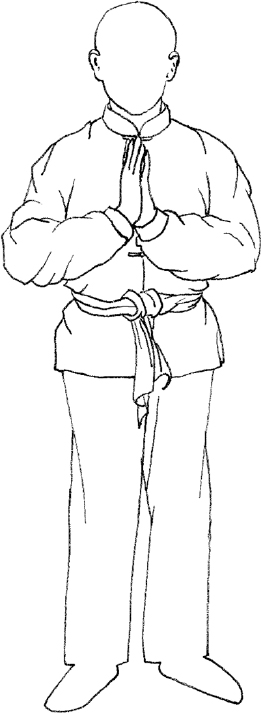
Routine 2: Wei Tuo presenting the Pestle 2 
(1)(Continued from Routine 1) Lift the elbows and hold the hands at shoulder level in front of the chest, with the fingers pointing to each other and the palms facing down; leave about one fist space between the hands and the chest.
(2)Stretch the arms out, with the palms facing down and the fingers pointing forward.
(3)Move the arms to the sides of the upper body and keep them at shoulder level, with the palms facing down and the fingers pointing outward (Wei Tuo presenting the Pestle 2).
(4)Put the fingers together. Bend the wrists to make the palms upright. Apply force at the base of the palms when pushing the palms to the right and left sides. Try to grasp the floor with the toes when bending the wrists and turning the palms upright. Look straight ahead and downward.
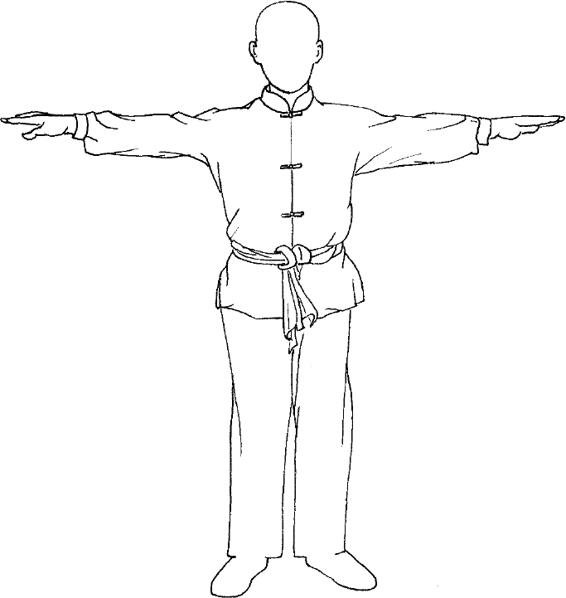
Keep your mind at ease and your thoughts calm while looking ahead but concentrating on the Q. within. This routine can help to enhance the muscles of the shoulders and arms, and improve the mobility of the shoulder joints. It also helps to regulate the Q. or internal energy in the Heart and Lungs, and to improve respiration and Blood and Q. circulation.
Routine 3: Wei Tuo presenting the Pestle 3 
(1)(Continued from Routine 2) Relax the wrists, and move the arms in a curve to the front. Bend the elbows to put the arms in front of the chest, with the fingers pointing to each other and the palms facing downward, leaving about one fist space from the chest. Look straight ahead and downward. (Similar to movement 1 in Routine 2.)
(2)Turn the palms outward and raise them to a position below the ears, with the palms up, the thumbs pointing to each other, and the elbows at shoulder level.
(3)Raise the heels and lift the hands above the head, with the palms facing upward. When lifting the hands, balance your body on the balls of the feet, and apply strength up along the arms and down along the legs. Straighten the spine, and move the body weight slightly forward. Stretch the elbows. Pull in the chin with the tongue touching the upper palate and keep the teeth clenched (Wei Tuo presenting the Pestle 3).

Maintain this position for a while.
By moving the upper limbs and raising the heels, the Q. or internal energy of the San Jia. viscera (the three portions of the trunk housing the internal organs) is regulated. Moreover, all the vital energy is mobilized from San Jiao. from the three Yin channels of both hands and feet, and from the internal organs. This routine also helps to improve the mobility of the shoulder joints, enhance the strength of the limb muscles, and invigorate the overall blood circulation.
Routine 4: Plucking a star and exchanging a star cluster 
(1)(Continued from Routine 3) Slowly lower the heels. Form fists, with the palm side facing outward, and lower the arms a little bit. Loosen the fingers slowly, relax the whole body, and look ahead and downward (Plucking a star and exchanging a star cluster).
(2)Turn the body to the left. Bend the knees, and move the right arm down past the front of the body to outside the left hip bone to “pluck a star,” with the right palm open. Move the left arm from the side of the body down to the back of the body, with the back of the hand slightly touching the Mingmen. point (DU 4, at the back of the waist). Look at the right hand.

(3)Straighten the knees and stand upright. Move the right hand past the front of the body upward to the right above the head. Relax the wrist, and bend the elbow slightly with the palm down. The forefingers should point to the left with the middle finger vertical at the Jiany. point (LI 15, at the lateral end of the top of the shoulder). Cover the left hand at the Mingmen. point (DU 4), with the mind focused on this point. When raising the right hand, follow it with the eyes, and keep the eyes fixed on it when it is in position. Remain in this position for a short while, and then move the arms to the sides of the body.
Repeat the above routine on the right side (the same movements as described above but in the opposite direction). Move the waist first, and then the shoulders and the arms when turning the body.
This routine will help to move the Q. (or vital energy) down to the kidneys and Mingmen. point (DU 4) area. It can strengthen the waist and Kidneys, delay aging, and promote longevity. It can also enhance the flexibility of the neck, shoulders, and waist.
Routine 5: Pulling nine cows by their tails 
(1)(Continued from Routine 4) Bend the knees slightly. Move the body weight to the right. Take a step back to the left at about 45°. Turn the right heel inward. Bend the right knee to take a bow stance. Turn the left hand inward, and move forward and then down in a curve to the back of the body. Gradually bend the fingers from the little finger to the thumb to form a fist, and hold it up, with the palm side facing up. Move the right hand forward and upward in a curve, and gradually bend the fingers from the little finger to the thumb to form a fist, and hold it up a little higher than the shoulder, with the palm side up. Look at the right fist.
(2)Move the body weight backward. Bend the left knee slightly. Turn the waist slightly to the right before twisting the shoulders, followed by the arms. Turn the right arm outward and the left arm inward. Bend the elbows to withdraw the arms. Look at the right fist (Pulling nine cows by their tails).
(3)Move the body weight forward. Bend the right knee to form a bow stance. Turn the waist slightly to the left, then the shoulders, and finally the arms. Relax the shoulders, and stretch the right arm forward and the left arm backward. Look at the right fist. Repeat the movements two or three times.
(4)Move the body weight onto the right foot. Withdraw the left foot, and turn the toes of the right foot to the front to assume a starting position with the feet apart. Let the arms hang loosely, and look ahead and downward.
Repeat the above movements from the left side (the same movements in the opposite direction).
Turning the waist and shoulder blades can stimulate such points on the back as Jiaji. (17 points on each side of the spine), Feishu. (BL 13, back shu. point of the Liver), and Xinshu. (BL 15, back shu. point of the Heart), dredge the related channels, and exercise the heart and lungs. Coordinated motion of the limbs can improve blood circulation in the soft tissues, and enhance muscle strength and mobility.
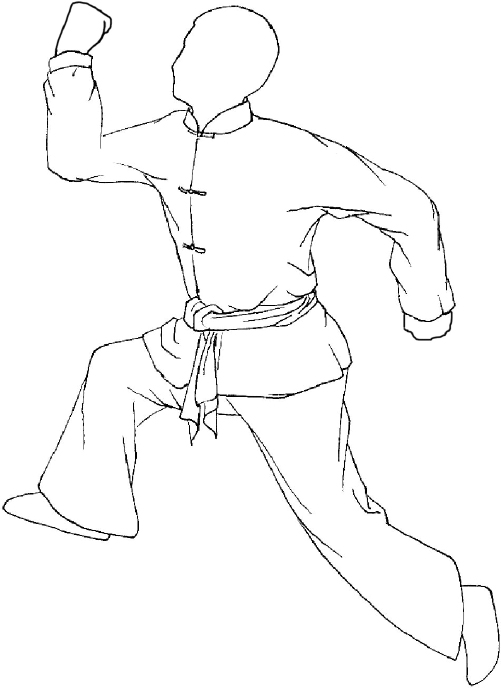
Routine 6: Displaying paw-style palms like a white crane spreading its wings 
(1)(Continued from Routine 5) Move the body weight onto the left foot. Withdraw the right foot to stand with the feet apart. Turn the right arm outward and the left arm inward, and move them to the sides of the body at shoulder level, with the palms facing forward. Move the arms in a curve to the front of the chest for a hollow hold with the palms facing each other. Straighten the fingers and put them in front of the Yunmen. points (LU 2, below the collarbones), with the palms facing each other and the fingertips pointing upward. Look ahead and downward.
(2)Expand the shoulders and chest. Relax the shoulders. Slowly stretch the arms forward, and turn the palms facing forward and the fingers pointing upward. Form lotus leaf palms by completely straightening and separating the fingers. Make the eyes glare (Displaying paw-style palms like a white crane spreading its wings).
(3)Loosen the wrists. Bend the elbows, and withdraw the arms to make lotus leaf palms in front of the Yunmen. point (LU 2). Look ahead and downward.
TCM theory holds that “the Lungs are the home of the Q. or internal energy, and they regulate the breathing.” The movements of the arms, hands, shoulders, and chest help to open and close such points as Yunmen. (LU 2) and Zhongf. (LU 1, below Yunmen). They enhance the converging at the chest of fresh air and the body’s internal Qi. thus improving both the breathing and the circulation of Blood and internal energy. This routine also enhances the strength of the muscles in the chest, back, and upper limbs.
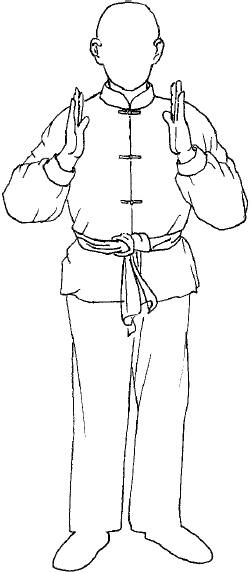
Routine 7: Nine ghosts drawing swords 
(1)(Continued from Routine 6) Turn the body to the right. Turn the right hand outward, with the palm facing up. Turn the left hand inward, with the palm facing down. Move the right hand from the front of the chest, past the right armpit, to the back of the body, with the palm facing out. Move the left hand from the front of the chest to the front, with the palm facing out.
(2)Turn the body slightly to the left. Lift the right hand past the right side of the body to the front of the head. Bend the elbow. Move the hand in a half circle around the head to cover the left ear. Move the left hand down from beside the left side of the body to the left behind the body. Bend the elbow. Touch the spine with the back of the left hand, with the palm facing back and the fingertips pointing up. Turn the head to the right. Press the left ear with the middle finger of the right hand. Press the Yuzhe. point (BL 9) lightly with the right thumb (the thumb should naturally fall in this area at the back of the head). Keep looking at the right hand, and then look back to the left when the motion is finished (Nine ghosts drawing swords).
(3)Turn the body to the right. Expand the arms and chest. Look upward to the right, and maintain this position for a while.
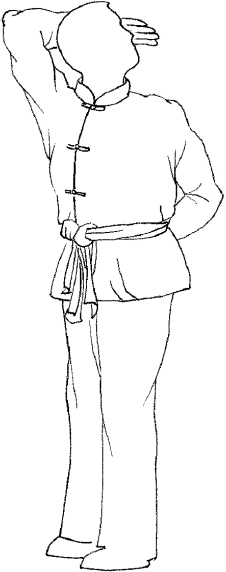
4)Bend the knees. Turn the upper body to the left. Withdraw the right arm. Tuck the chest in. Push the left hand along the spine as far as possible. Look at the right heel, and maintain this position for a while. Repeat these movements two or three times.
(5)Straighten the knees, and turn the body to face forward. Move the right hand above the head, and down to the right side at shoulder level. At the same time, lift the left hand from beside the body to shoulder level, with both palms facing down. Look ahead and downward.
Repeat the above movements from the left side (the same movements in the opposite direction).
Apply as much strength as possible when stretching in different directions. Bend and flex the body in a coordinated and unrestrained way. Breathe naturally when expanding the chest and arms, and exhale normally when relaxing the shoulders and lifting the arms.
As the body flexes and stretches, the passages for the Q. or internal energy are opened and closed in a rhythmical way, so that the spleen and stomach are massaged and the kidneys strengthened. The movements also help to dredge such important points as Yuzhe. (BL 9) and Jiaji. This routine enhances the strength of the muscles of the neck, shoulders, waist, and back, thus improving the mobility of various joints.
Routine 8: Three plates falling on the floor 
(1)Move the left foot one step to the left, with the feet shoulder-width apart. The toes should be facing the front. Look ahead and downward. Bend the knees to adopt a squatting position. At the same time, relax the shoulders and lower the elbows. Lower the hands to a position level with the Huantia. point (GB 30, on the upper outside of the thigh). Bend the elbows slightly, with the palms facing down and the fingers pointing outward. Look ahead and downward (Three plates falling on the floor).
Exhale to pronounce the sound “hai” and place the tongue between the upper and lower teeth at the end of the sound. This sound assists the passage of breath and vital energy down to the Dantia. (or elixir field) point, which is about 2 inches below the navel. When pronouncing “hai,” open the mouth slightly. Apply strength to the Yinjia. point (DU 28, on the upper jaw in the area of the two front teeth). Relax the lower lip. There should be no strength applied to the Chengjiang. point (RN 24, on the lower gum). The sound should be produced from the throat.
(2)Turn the palms upward. Bend the elbows slightly, and lift the arms to the sides at shoulder level. Then stand up slowly. Look forward.
(3)Repeat movements 1 and 2 three times. Squat slightly the first time, take a half squat the second time, and completely squat down the third time. Relax the waist and tuck in the buttocks when squatting down, as if holding a heavy weight in the hands. When standing up, also imagine holding a huge weight. Gradually increase the range of squatting. The range can be adjusted according to individual conditions for older or weaker practitioners. Young, healthy practitioners may assume a half or compete squat. Keep the upper body straight. Avoid tilting forward or backward when squatting down and straightening up.
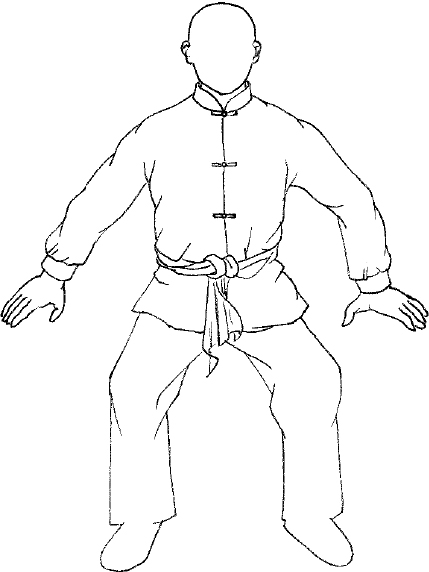
The bending and stretching of the lower limbs combined with the pronunciation of the sound “hai” helps to raise and lower the Q. or internal energy in the chest and abdominal cavities. It also helps the exchange of fluids of the Heart and Kidneys, and their interaction. In addition, it enhances the strength of the waist, kidneys, abdomen, and lower limbs, and strengthen the Q. at the Dantia. point (about 2 inches below the navel).
Routine 9: The black dragon displaying its claws 
(1)(Continued from Routine 8) Withdraw the left foot half a step, with the feet shoulder-width apart. Form fists, and place the ulnar sides of the fists at the Zhangmen. points (LR 13) at the sides of the waist, with the palm sides facing up. Look ahead and downward. Loosen the fingers of the right fist. Straighten the right arm up, and move it down to the outer right side, to a position a bit lower than the shoulders, with the palm up. Gaze at the hand.
(2)Bend the elbow of the right arm, and tuck in the wrist. Make the right palm into a dragon’s claw by straightening the fingers and keeping them apart, with the thumb, forefinger, ring finger, and little finger appropriately withdrawn, pointing the fingertips to the left. Move the hand horizontally leftward, following the movement with the eyes. Turn the body 90° to the left, and look in the direction pointed to by the right hand (The black dragon displaying its clawsr).
(3)Loosen the fingers of the right hand. Tilt the upper body to the left and forward, and press the right palm down to the outside of the left foot. Look downward. Move the left-tilted body to the right and into a forward-tilted position, bringing the right hand in a curve from the front of the left knee to the outside of the right knee. Turn the right arm outward, with the palm facing forward, and make a fist of the right hand. Follow the movement of the hand with the eyes.
(4)Straighten the body. Withdraw the right fist to the right Zhangmen. point (LR 13), resting both fists at the sides of the waist, with the palm side up. Look ahead and downward.
Repeat the above routine from the right side (the same movements in the opposite direction).
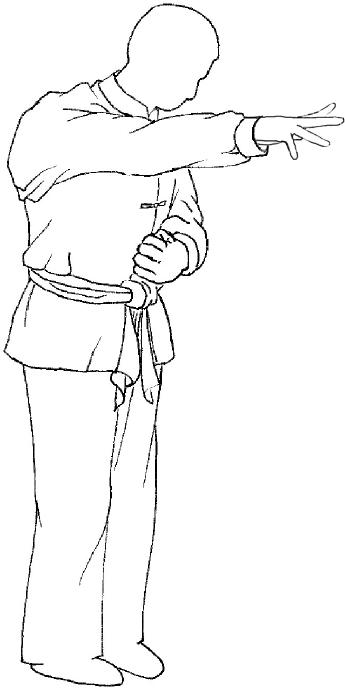
“The two sides of the waist are in the domain of the Liver. The Liver is the home of Blood and the Kidneys are the home of the reproductive Essence,” according to the theory of TCM. Such movements as turning the upper body, displaying the dragon’s claw to the left and right, and bending the upper body help to stretch and relax the sides of the chest. They can also dredge the channels of the Liver and Qi. and soothe the mind and mood, besides improving the mobility of the waist and lower limbs.
Routine 10: The tiger springing at its prey 
(1)(Continued from Routine 9) Turn the toes of the right foot inward about 45°. Withdraw the left foot to the inside of the right foot to form a T-stance. Turn the body 90° to the left. Place the fists at the Zhangmen. points (LR 13) at the sides of the waist. Look directly forward as the body turns to the left.
(2)Take a big step forward to form a left T-stance. Place the fists at the Yunmen. points (LU 2, near the collarbones). Turn the fists inward to make a tiger’s paws (keep the fingers apart, with the thumb and forefinger fully apart and the first and second knuckles bent). Leap forward like a tiger springing at its prey. Bend the elbows slightly. Look straight ahead.
(3)Bend and expand the upper body gradually from the waist to the chest, and move the body weight forward. Move the hands in a circle down the body, backward, upward, and forward. Tilt the upper body forward. Press the tiger’s paws down to touch the floor with the fingers. Bend the rear leg to touch the floor with the toes, with the front heel slightly raised. Hold the waist tightly and thrust the chest forward. Raise the head. Make the eyes glare. Maintain this position, looking upward and straight ahead (The tiger springing at its prey). Older or weaker practitioners may press the tiger’s paws only as far down as the sides of the left knee.
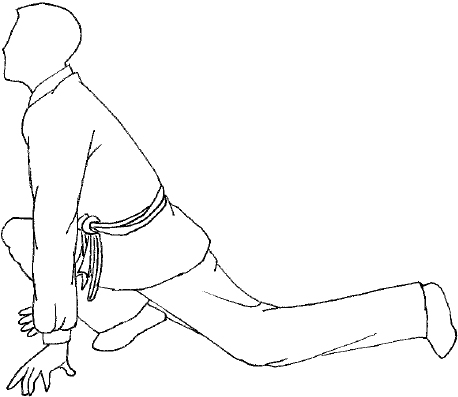
(4)Stand up and hold the fists at the Zhangmen. points (LR 13) at the sides of the waist. Move the body weight backward. Turn the toes of the left foot about 135° inward, and move the body weight to the left. At the same time, turn the body about 180° to the right. Withdraw the right foot to the inside of the left foot, to form a T-stance.
Repeat the above movements from the right side (the same movements in the opposite direction).
The theory of TCM holds that the Re. Meridian or Conception Vessel is the source of the Yin meridians, and directs the Yin meridians all over the body. The tilting backward of the body and the flexing of the chest and abdominal cavities help to dredge the Re. Meridian and regulate the Q. or internal energy flowing through the three Yin meridians of the hands and feet. This routine also improves the flexibility of the muscles of the waist and legs.
Routine 11: Bowing down in salutation 
(1)(Continued from Routine 10) Raise the upper body, and move the body weight backward and the face forward. Turn the toes of the right foot inward, with the toes pointing forward. Withdraw the left foot, to stand with the feet apart. When turning the body to the left, loosen the hands, and turn them outward, with the palms facing forward. Raise them to the sides at shoulder level. Bend the elbows to cover the ears with the palms, and press the nape of the neck with the fingers, which point to each other. Tap this area seven times with the index and middle fingers. Look ahead and downward.
(2)Tilt the upper body forward, and slowly stretch and flex from the cervical, thoracic, and lumbar vertebrae down to the coccygeal vertebrae. Straighten the thighs, look at the toes, and remain in this position for a while.
(3)Gradually straighten the upper body, starting with the coccygeal vertebrae, through the lumbar, thoracic, and cervical vertebrae, up to the head. Cover the ears with the palms, and press the nape of the neck with the fingers pointing to each other. Look ahead and downward.
Repeat movements 2 and 3 three times; gradually increase the motion range when tilting and bending the upper body forward, pausing for a while. Bend the upper body forward less than 90° the first time, about 90° the second time, and more than 90° the third time (Bowing down in salutation).
Older or weaker practitioners may restrict the bend to about 30°, 45°, and 90°, respectively. When tilting the upper body forward, try to stretch and flex the spine so that the neck and head are bent like a hook. The range of the tilt should be adjusted according to the individual conditions of older or weaker practitioners.
TCM theory states that the D. Meridian (Governor Vessel) is one of the Yang meridians, and governs the Q. or the vital energy flowing through the Yang meridians, including those passing through the cervical, thoracic, and lumbar vertebrae down to the coccygeal vertebrae. If it is fully exercised, all the Q. or vital energy in those channels will be mobilized and transferred throughout the body to enhance overall health and fitness. This routine can also improves the mobility of the waist, back, and lower limbs, to enhance the functions of the waist and legs. Tapping the nape of the neck helps to refresh the brain, increase the hearing capacity, and reduce brain fatigue.
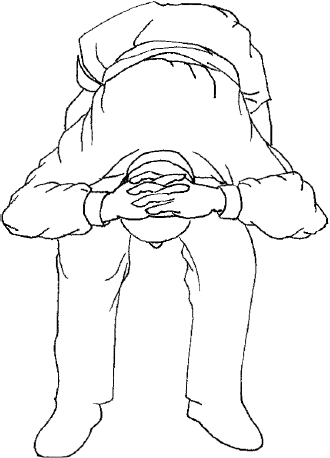
Routine 12: Swinging the tail 
(1)(Continued from Routine 11) Stand erect, and lift the hands off the ears with a deft movement. Stretch the arms forward, with the fingers interlaced and the palms facing yourself.
(2)Bend the elbows and push the hands out, with the palms facing outward. Bend the elbows, turn the palms down, and withdraw them to the front of the chest. Tilt the upper body forward, tighten the waist, and raise the head. Press the hands down slowly, with the fingers interlaced. Look straight ahead (Swinging the tail). Older or weaker practitioners may bend the upper body forward, with the head raised, and slowly press the hands down to in front of the knees.
(3)Turn the head left and look back. Meanwhile, move the buttocks forward to the left, and look back at where the sacrum is located. Keep the fingers interlaced, then relax the palms and raise the head to face forward. Turn the head right and look back. Meanwhile, move the buttocks forward to the right. Look back at where the sacrum is located.
(4)Keep the fingers interlaced, then relax the palms and raise the head to face forward.
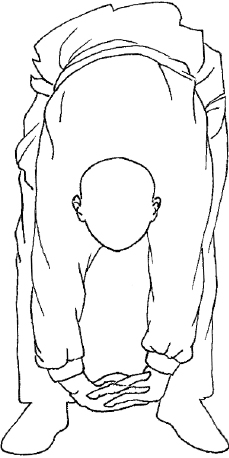
Repeat movements 3 and 4 three times. Turn the head and move the buttocks in such a way that the head and buttocks move toward each other. The motion of the head should be slow, and the range of turning should be reduced for older or weaker practitioners, and those with hypertension or neck problems.
Bending the body, raising the head, and swinging the buttocks to the left and right can integrate the vital energy especially in the D. and Re. Meridians, as well as in all the other channels of the body. This routine loosens the whole body for total relaxation. It can also enhance the strength of the waist and back muscles, and improve the mobility of the various joints and muscles along the spine.
Closing form
(1)(Continued from Routine 12) Loosen the fingers, spread the arms outward, and stand straight. Meanwhile, lift the straightened arms to the sides at shoulder level, with the palms facing up. Raise the arms over the head, with the elbows bent and the palms facing down. Look ahead and downward.
(2)Relax the shoulders. Bend the elbows, and withdraw the hands past the head, face, and chest to the front of the abdomen, with the palms down. Look ahead and downward.
Repeat movements 1 and 2 three times. Relax the arms, and let them hang down by the sides of the body. Withdraw the left foot, and stand straight with the feet together. Rest the tongue on the upper palate. Look straight ahead.
When the hands are moved down the first two times, concentrate the mind on the motion down to the floor, through the Yongqua. points (BL 1) on the soles of the feet. When the hands are moved down for the third time, the mind should follow the motion down to the abdomen, and linger there. When you are moving the hands downward, the motion should be slow and even-paced.
Lifting the hands can guide the Q. or internal energy back to the Dantia. point. It can also help to relax all the muscles and joints in the body.
Summary
The above section describes all 12 routines of Yi Jin Jing. Remember that all movements should be relaxed, smooth, and graceful, with natural breathing. Deeper and longer breathing can be adopted at a later stage, after mastering the basic movements. Achieving and maintaining a calm and peaceful state is very important before, during, and after the practice. You should feel refreshed and energetic after practicing Yi Jin Jing.
The Five Animal Frolics (Wu Qin X., 五禽戏)
Introduction
Five Animal Frolics Qigong. also called Wu Qin X. ( ), is an 1800-year-old Chinese exercise system for fitness, good health, and longevity. It is the most ancient Qigong. system still practiced today. It was developed at the end of the Eastern Han Dynasty (25–220 A.D.) in China by the prominent physician Hua Tuo (~145–208 A.D.). Hua Tuo had mastered many facets of medicine, including surgery. He is acknowledged as the first doctor in China to use anesthesia during surgery and is considered by some to be one of the fathers of Chinese medicine.
), is an 1800-year-old Chinese exercise system for fitness, good health, and longevity. It is the most ancient Qigong. system still practiced today. It was developed at the end of the Eastern Han Dynasty (25–220 A.D.) in China by the prominent physician Hua Tuo (~145–208 A.D.). Hua Tuo had mastered many facets of medicine, including surgery. He is acknowledged as the first doctor in China to use anesthesia during surgery and is considered by some to be one of the fathers of Chinese medicine.
As a physician with a very busy practice, Hua Tuo realized that patients often came to him for treatment in hopes of being restored to health only when they were in the final stages of illness. He was frustrated; he believed that the best way to improve one’s health and cure disease was to avoid illness altogether or, at the very least, to treat it much earlier so as to prevent it from reaching a critical stage. This echoes the saying that the best doctor cures disease and illness before the symptoms even appear and become tangible, as noted in the first Chinese medicine book, The Inner Canon of Yellow Empero. .
Hua Tuo summarized and developed a set of exercises that alternated motion with stillness, stretching with quiet repose, and shared the fruits of his research and teachings with select disciples. The practice of mimicking animals as an exercise actually predates the Han Dynasty. Zhuang Zi. written in the Eastern Zhou Dynasty (770–256 B.C.) and named for its author, Daoism philosopher Zhuang Zi (369–286 B.C.), refers to this technique. However, Hua Tuo was the first to summarize the method systematically while simplifying the movements into easy-to-learn steps. His two disciples, Wu Pu and Fan A, practiced these exercises faithfully and lived long, healthy lives. Wu Pu died at 90, while Fan A lived to over 100 years of age. Wu Pu described the exercises in his own book, The Five Animal Classic. where he quoted Hua Tuo’s words: ‘‘The body should be exercised, but not to excess. Exercise improves digestion and keeps the meridians clear of obstructions. In this way, the body will remain free of illness. A door hinge does not rust if it is frequently used. Therefore the ancient sages practiced ‘Daoyi.’ (stretching exercises) … I have created a Daoyi. method called the Five Animal Frolics. It can eliminate sickness and strengthen the root.”
Characteristics
The Five Animal Frolics, or Wu Qin Xi. imitates the postures and behavior of the Tiger seizing, the Deer stretching, the Bear crawling, the Monkey jumping, and the Crane flying in order to strengthen the internal organs and harmonize the five elemental energies (Fire, Water, Earth, Wood, and Metal) to attain health and longevity (Drawings of Five Animal Frolics exercises). By practicing these simple forms of movement, meditation, and the spontaneous play of animals, the channels are relieved of obstruction and Q. flows freely. Jing, Qi. and She. (Essence, Vital Energy, and the Spirit of information) are cultivated internally, while the improved condition and function of the bones, joints, tendons, muscles, circulation, hair, and skin manifest externally. Hua Tuo’s theory is: Regular, systematic movement can dissipate the food Q. of digestion and allow the free flow of Blood through the channels so that illness cannot occur.
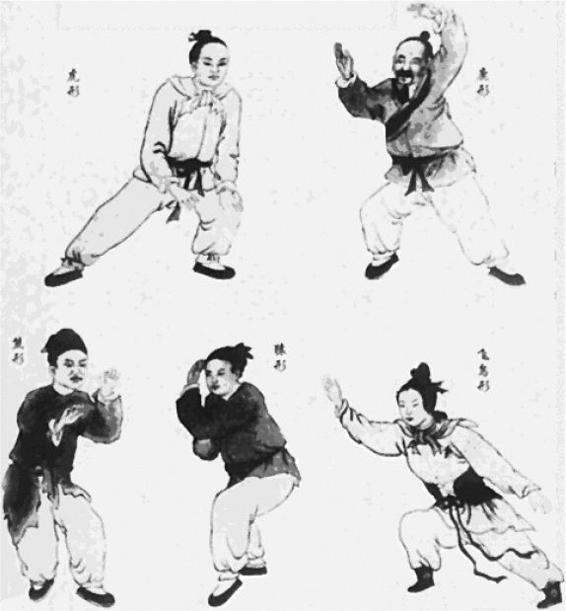
As mentioned in the Introduction, Hua Tuo had instructed his disciple Wu Pu on the role played by regular but balanced exercise in human health. Inspired by the ancients who “stretched their necks like that of a horned owl” and “stretched their waists; moving around their joints, all in efforts to delay aging,” Hua Tuo summarized and created his “technique called ‘movements of the five animals.’ The first is called ‘the Tiger’, the second is ‘the Deer’, the third is ‘the Bear’, the fourth is ‘the Ape’ and the fifth ‘the Bird’; useful in preventing illnesses, and beneficial to the limbs because they are a form of stretching. If your body experiences some discomfort, simply perform one of the animal exercises. Upon sweating, sprinkle some powder on yourself and your body will feel relaxed” and you will have a healthy appetite.
The Five Animal Frolics, like other Qigong. practices, combine and balance internal and external movement, dynamic and tranquility states, and mental and physical activities. Thus, the whole itself is integrated. The exercises comprise easy-to-learn steps that are honed through practice. A good practitioner who has devoted time to learning the exercises can feel the positive energy of the Five Animals within the body.
The five animals and their attributes
(1)The Tiger represents muscular strength and is a symbol of courage and ferocity. The Tiger exercises strengthen the Lung and sinews, the Kidney and waist area, and help to develop a strong body and build internal power.
(2)The Deer, a symbol of longevity, represents grace, strength, and sensitivity. The Deer exercises strengthen the Spleen organ system and relax the muscles, and give a long stretch to the legs and spine, creating open, expansive, and coordinated movement with very flexible sinews and bones.
(3)The Bear, with its Yang energy, has a strong, stable, and rooted power. The Bear exercises mimic the turning motions and grounded nature of the bear. These exercises warm and stimulate the entire body, giving strength in particular to the waist and lower body. Bear Frolics can improve the function of the Kidney and Spleen, strengthening the bones and the digestive process. Thanks to the pivotal movements, all the viscera receive a stimulating massage.
(4)The clever Monkey represents suppleness and agility. The Monkey is intelligent, alert, and nimble. The Monkey exercises strengthen the Liver organ system and benefit the tendons and ligaments.
(5)The Crane, another symbol of longevity, represents balance, lightness, calm, and relaxation. The Crane exercises cool and relax the whole body, balance the Heart energy, strengthen the Heart organ system, the Lung and circulation system, and gently stretch the ligaments and release the spine.
Five Animal Frolics and Five Elements, Foundation Exercises:The Crane and the Bear
Each of the Five Animal Frolics relates to one of the Five Elements. The Five Elements are Wood, Fire, Earth, Metal, and Water. They are a Chinese concept that can be used to describe almost everything and also the relationship between things. For this Qigong. exercise, the Five Elements are used to represent which organ system the exercises are focusing on. Although each set of exercises focuses on a specific organ system, the organ systems are related and their proper functioning depends upon each other. To benefit from these exercises you do not have to understand the Traditional Chinese Medical Theory or the Five Elements Theory. The benefit comes from the practice of the exercises, and understanding the theories will help but is not necessary. Table 25.1 shows the order in which the exercises are learned and their Five Elements Theory correlation.
The Crane and Bear Frolics are the foundation exercises. A glance at Table 25.1 will reveal that these two animals represent Yin and Yang, respectively. As might be expected, there are Yin and Yang aspects to both the exercises. By learning and practicing the Crane and Bear Frolics, one can reap many health benefits.
The crane is a symbol of meditative stillness and longevity with a strong link to Chinese culture, ancient and modern. In Chinese mythology, the crane is the companion of Lao Shou Xing, the God of Long Life and Luck. The Yellow Crane Tower, still standing in Wuhan, celebrates the Daoist legend of the enlightened sage who flew to immortality on the back of a yellow crane.
In many cultures, the bear is a symbol of strength, power, and healing wisdom. However, in China, the bear holds special meaning. Huangdi, the Yellow Emperor, was of the Youxiong (literally, “having bear”) people, whose original symbol was the bear. As well, in ancient China, the shaman-healers wore bear skins in rituals and would have, as in other animist societies, considered the bear a wise teacher.
Preparation of the Five Animal Frolics
The mind preparation: keep a calm and stable mental state, and avoid any emotion or thought which could disturb your body and organs.
The breath preparation: keep a natural and smooth breath during the exercises. You may gradually take increasingly slow and deep breaths when you have learned to coordinate the physical exercises and breathing exercises.
The body preparation: keep the body in a natural and relaxed position before the exercises, with the head and back erect, the chest arced in, the shoulders drooping, and all the muscles relaxed. Practice each movement at the appropriate level, strength, and speed accordingly during the exercise. Return the body to a natural and relaxed position after the exercises or between the exercises.
The spirit preparation: keep the integration of the body and spirit during the exercises. The spirit is the foundation of adjusting and supporting the physical movements and imitating the animals. A close imitation of the spiritual expressions of animals gives pleasure to practitioners, and the integration of the body and spirit makes the movements more effective and accurate.
The Five Animal Frolics are an all-round set of movements, in which the trunk and limbs are stretched in all directions and the joints are flexed. Exercises of the fingers and toes are particularly emphasized for improving the blood circulation to the extremities. The movements of the Five Animal Frolics are rather simple and symmetrical. One may perform either a complete set of exercises or a particular exercise repeatedly.
The Five Animal Frolics have external and internal exercises to relax the body and concentrate the mind. The external physical activities should follow and obey the internal will and thought. In the meanwhile, the dynamic physical movements should be integrated with the breathing exercises and the static exercises of the mind.
Because of the long history of the Five Animal Frolics, there exist many variations of these exercises. Some versions have single exercises for each animal or many exercises for each animal, some versions mimic the movements and characteristics of each animal, and some versions do not seem to relate to the animals at all except in name. The version we have introduced here is one of the popular exercise versions which have been practiced by many people for a long time.
The Routines of the Five Animal Frolics
All routines of the Five Animal Frolics start and end with a natural position which assumes an erect but comfortable stance, with the feet shoulder-width apart and the hands hanging at the sides. After the exercises, stand in quiet meditation for a moment. You may walk meditatively for a minute or two and reflect on any feelings or sensations that occurred during the exercises.
1) The tiger frolics (Tiger exercise)
The Tiger exercises should be performed vigorously, but with some softness from within to exhibit the tiger’s courage and fierceness.
Routine 1: Raising the tiger’s paws
Let the arms hang loosely, with the palms facing the ground and the fingers spread and flexed, like the paws of a tiger. Then form fists and raise them slowly in front of the body to shoulder height. Unclench the fists and raise the hands as high as possible over the head. Clench the fists once again; turn the palms to face each other. Lower the fists to shoulder level and unclench the fists. Lower the hands with the palms down to the front of the abdomen. Repeat the above movements three times, and then return to the natural position.
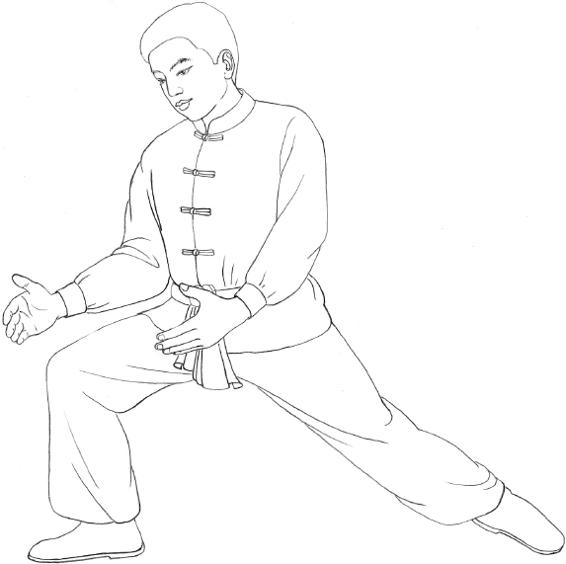
Routine 2: Seizing the prey
With both fists loosely clenched and raised along the sides of the body to shoulder level, stretch both hands straight out and swing in an arc, bending the upper body forward. Bend the knees to assume a squatting position. Both hands, as a tiger’s paws, move down to the outside of the knees.
Then both knees are extended, the hips and abdomen move forward, and the upper body inclines backward, with the hands moving to chest level. The left leg is lifted from the ground, with the knee flexed and the hands raised.
Then move forward one step to touch the ground with the heel, and the right knee is bent to lower the body to a squatting position. The hands are changed into a tiger’s paws and extended forward — like a tiger pouncing on its prey. Then return to the natural position.
Repeat the above movements with the position of the left and right sides of the body performed in reverse, and then return to the natural position.
2) The deer frolics (Deer exercise)
The Deer exercises should be performed lightly and gently, with the limbs extended in a comfortable and calm spirit.
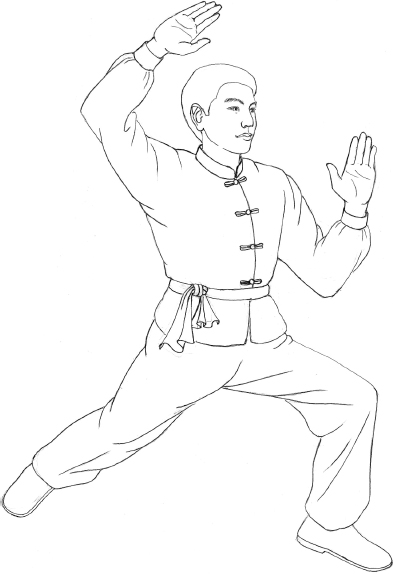
Routine 1: Colliding with the antlers
Put the left foot forward with the heel touching the ground, both legs slightly bent, and the body weight resting on the right leg. Turn the body slightly toward the right, with both palms forming hollow fists and moved to the level of the right shoulder.
With the body weight shifted forward, the left foot is placed firmly on the ground. Turn the body to the left, and both palms move upward and then to the left and backward with the palms facing outward and the fingers pointing backward. The left arm is flexed, adducted, and horizontally extended, with the elbow touching the left side of the waist. The right arm is raised to the level of the forehead, and then extended backward to the left side, with the palm facing outward and the fingers pointing backward.
Then the body is turned to the right side, and the left foot is withdrawn to stand with the feet apart. At the same time, the hands are moved to the right in an arc and changed to hollow fists. Finally, the hands are dropped to hang at the sides.
Repeat the above movements, reversing the positions of left and right, and then return to the natural position.
Routine 2: Running like a deer
Extend the left leg forward with the knee flexed. Change the hands to hollow fists and move upward and forward to the shoulder level. The flexed wrists are shoulder-width apart, with the bottom of the fists facing down.
Shift the body weight to the back foot, and flex the right knee. Bend the neck and back forward, with the abdomen contracted and the head facing down. At the same time, both arms are rotated and both hands are extended forward with their dorsa facing each other.
The upper body is made erect, and the weight is shifted forward onto the left leg, with the left knee flexed and the right leg straightened to a form a left bow stance. The shoulders are relaxed, with the elbows facing downward and the hands changed back to hollow fists. Then return to the original position.
Repeat the above movements, reversing the positions of left and right, and then return to the natural position.
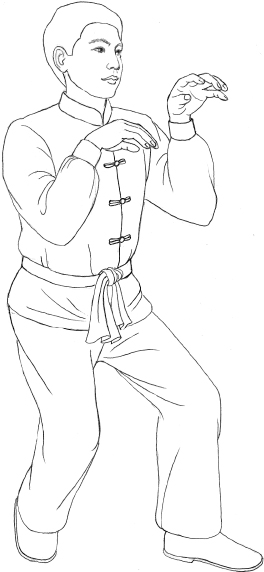
3) The bear frolics (Bear exercise)
Although it may seem contradictory, the overall energy of the Bear Frolic is grounded, heavy, and stable, yet it is important to move in a coordinated and agile manner. As Kenneth Cohen states in The Way of Qigong. “This is consistent with the nature of the bear, who can amble about slowly or charge with surprising speed.”. It is common to feel much more grounded after completing these exercises.
Table. 25.1.The Five Animal Frolics and the Five Elements Theory.

These exercises warm the body and deepen respiration. They benefit Kidney and adrenal function, and increase waist and lower body strength. The Bear Frolics are identified as a Yang exercise but may be practiced all year. However, the warming and strengthening are wonderful benefits for winter and fall, the more Yin seasons.
The Bear Stance is the starting point for the following exercises. Stand straight and centered, with the arms hanging loosely at the sides, and the waist and hips relaxed. Look straight ahead with a relaxed gaze. Allow the Q. to sink well into the Dantian. Place the feet approximately shoulder-width apart, with the toes pointing outward at 45°. Bend the knees slightly.
With practice, the knees may be bent so that the thighs are parallel to the ground. However, this advanced deep stance is not to be assumed by pregnant or menstruating women.
As with the Crane Frolics, the exercises are repeated nine times per side. The transition from one exercise to another is smooth and includes a brief pause.
Routine 1: The bear turns
From the Bear Stance, raise the arms at the sides of the body and bend the elbows 90°, with the hands facing the palms upward at ear height. Exhale while rotating the upper body slowly from the waist to the left. Keep the hips and thighs fixed so that the rotation occurs only from the waist. Rotate only as far as can be managed without strain. Inhale slowly and return to the center. Exhale and rotate the upper body slowly from the waist to the right. Inhale slowly and return to the center. Continue the repetitions, coordinating the rotation and breath. After the last repetition, go straight into “The Bear Pushes Behind.”
Routine 2: The bear pushes behind
With exhalation, rotate the upper body to the left, straighten the left arm, and push the left hand out behind the body. The left arm remains at shoulder height, with the wrist flexed and the palm facing outward. Inhale slowly, rotating the upper body back to the center, and bending the left elbow 90°. Exhale and rotate the upper body to the right, straighten the right arm, and push the right hand out behind the body. The right arm remains at shoulder height, with the wrist flexed and the palm facing outward. Inhale slowly, rotating the upper body back to the center, and bending the right elbow 90°.
Routine 3: The bear pushes down
From the Bear Stance, raise the arms at the sides of the body and bend the elbows 90°, with the hands facing the palms upward at ear height. Exhale slowly while rotating to the left; straighten the left arm while bringing the left hand down behind the body until the hand is pushing the palm downward near the left hip. Inhale slowly and rotate the body to the center; raise the left arm while bending the elbow 90° to return it to the starting posture. Exhale slowly while rotating to the right; straighten the right arm while bringing the right hand down behind the body until the hand is pushing the palm downward near the right hip. Inhale slowly, returning to the starting position.
Routine 4: The bear offering
In the Bear Stance, bend the elbows to place both hands, with the palms upward on the lower ribs, just below the sternum. Exhale and rotate the upper body from the waist to the left; straighten the left arm and extend the left hand, with the palms upward, away from the body at shoulder height (as though offering something). Extend the right hand slightly to rest it palm up on the middle of the left forearm. Inhale and rotate the upper body back to the center while returning both hands to the chest, with the palms upward. Exhale and rotate the upper body to the right; straighten the right arm and extend the right hand, with the palm upward, away from the body at shoulder height. Extend the left hand until it rests, with the palm upward, on the middle of the right forearm. Inhale slowly to return to the starting position.
Routine 5: The bear push
Begin from the position of the “Bear Offering” with both hands, the palms upward, on the lower ribs. Exhale and rotate the upper body to the left. Push both hands, with the palms facing away from the body, out to the left side. The push from both hands is equal in strength and direction, as though both palms were against a wall. Inhale slowly and rotate back to the center, returning the hands to the chest. Exhale slowly and perform the movement to the right side. Inhale slowly and return to the original position.
4) The monkey frolics (Monkey exercise)
The Monkey exercises should be performed to imitate the light and swift movements of the monkey, but keep your mind quiet and still in the meanwhile. So the monkey exercise is externally dynamic and internally static.
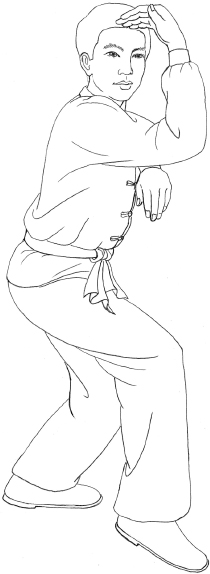
Routine 1: Lifting the monkey’s paws
Place both hands in front of the body, with the fingers extended and separated from each other. Lift the hands to chest level, with the fingers assembled to resemble the hook-like paws of a monkey. Lift the heels and turn the head to the left with the shoulders shrugged, the abdomen contracted, and the anus clenched.
Turn the head back to the normal position; relax the shoulders, abdomen, and buttocks. The heels are put back on the ground, and the hands are kept at shoulder level with the fingers extended and the palms facing down. Then return to the original position.
Repeat the above movements with the head turned to the right, and then return to the original position.
Routine 2: Picking fruit
Move the left foot to the left rear side, with the tips of the toes touching the ground and the weight being on the right leg. The right knee and left elbow are flexed and the left hand assumes shape of a monkey’s paw at the left side of the waist. The right palm is facing down and held at the front right side of the body.
Shift the weight backward to the left foot with the left knee flexed to enable a squatting position. Withdraw the right foot to the side of the left foot, with the toes touching the ground. The right palm is moved downward over the abdomen and then upward to the left side in an arc, to just beside the face, with the palm facing the left temple and the head turned up to the right front.
Move the right palm down, along the left side of the body, to the hip level. Move a big step with the right foot toward the right front, strengthen it and extend the left foot until only the tips of the toes are touching the ground, and shift the body weight to the right leg. Meanwhile, move the right palm up in an arc to the right until it is slightly above the shoulder to assume the shape of a monkey’s paw; while the left palm moves forward and upward with the wrist flexed and the fingertips together as if plucking fruit from a tree. The eyes should be fixed on the left hand.
Shift the weight backward, the left hand forms a solid fist, and the right hand hangs loose at the front right side of the body, with the thumb side facing the front. The left knee is flexed and the right foot is withdrawn to the side of the left foot, with the toes touching the ground. At the same time, the left elbow is flexed, and the left hand is withdrawn to beside the left ear, with the palm facing upward and the fingers separated, as if holding a peach. Move the right palm in an arc to just below the left elbow, to seemingly support it. The eyes are staring at the left palm. Then return to the original position.
Repeat the above movements with the left and right positions reversed, and then return to the original position.
5) The crane frolics (Crane Exercise)
The Crane exercises are designed to promote relaxation, improve balance, and cool the body. The elongated stretching movements loosen and open the joints, and can strengthen the heart and lungs. Some have found the exercise can help to reduce inflammation and relieve congestion. Thus, the Crane Frolics can bring a cooling, calming Yin influence to the more Yang seasons of the year, summer and spring.
The crane stance
All the Crane Frolic techniques begin from the Crane Stance. Maintaining the principles of Qigong. posture, stand with the heels together with a 45° angle between the feet. Bend the knees slightly while ensuring equal distribution of body weight over the soles of both feet. Lightly tuck the hips under while relaxing the chest and shoulders onto the torso. Draw in the chin slightly while aligning the head atop the spinal column. Imagine elongating the body so that it is light yet balanced from a strong footing. Keep the gaze long, soft, and relaxed. Allow the arms to hang naturally at the sides. Relax the Dantia. (elixir field) and lower abdomen.
The Crane Frolics are elegant and are performed at an even, meditative, and relaxed pace. Each exercise is repeated nine times per side. Following a brief pause, then the next exercise is performed.
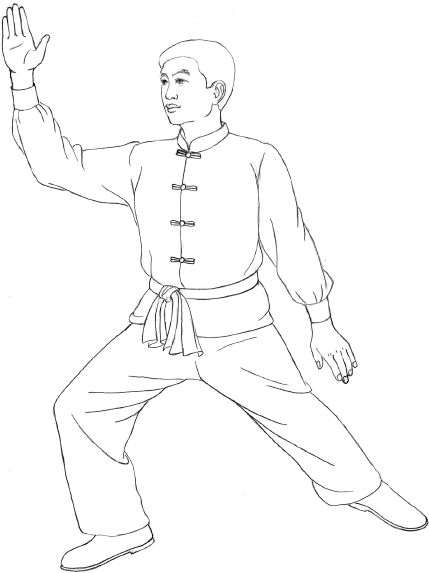
Routine 1: The standing crane
From the Crane Stance, move the arms forward so that the hands are just in front of the Dantian. with the palms upturned and the fingertips almost touching. With relaxed shoulders and chest, inhale slowly and bend the elbows to raise the arms so that the hands are just in front of the heart area. Exhale slowly and, keeping the palms upturned, lower the hands to the Dantian.
Routine 2: The crane’s beak
From the Crane Stance, raise the arms to the sides to shoulder height, with the palms facing downward. Ensure that the arms are aligned so that there is a straight but relaxed line along the shoulders, upper arms, forearms, wrists, and hands. Bend the elbows slightly. Inhale slowly and raise the arms about 6 inches higher while drawing together the fingertips of each hand, forming a Crane’s beak. Exhale slowly and relax open the Crane’s beak while lowering the arms about 6 inches.
Routine 3: The crane flaps its wings
From the Crane Stance, inhale and raise the arms to the sides to shoulder height, with the palms facing downward. Exhale slowly and lower the arms until the hands are waist-level. Inhale slowly and raise the arms gracefully to shoulder height, keeping the palms open and facing downward. After the last repetition, go straight into “The Crane Squatting.”
Routine 4: The crane squatting
Continuing from the end of “The Crane Flaps its Wings,” lower the hands to waist level, with the palms facing downward. Inhale slowly and go into a squat, allowing the knees to bow out to the sides. Lift the heels to balance on the front of the feet and squat as deeply as is comfortable. While squatting, raise the arms to shoulder height, with the palms upturned. Exhale and, while slowly coming out of the squat, lower the arms and turn the palms downward as they return to waist height.
Routine 5: The one-legged crane
From the Crane Stance, place the hands palms downward at waist level. Exhale slowly and squat while reaching forward and down with the arms, as if to embrace the knees. Inhale slowly and come out of the squat; shift the weight onto one leg, and cross the arms in front of the chest, with the palms facing the body. While still inhaling, bend the opposite knee to raise the leg until the thigh is parallel to the ground. At the same time uncross the arms, raise them overhead and then out to the sides at shoulder height. Balance in this position for a few seconds. Exhale slowly and resume the squatting position, repeating the exercise.
Routine 6: The crane spreads its wings
From the Crane Stance, move the feet to the parallel position, approximately shoulder-width apart. Inhale and draw both arms slightly back behind the body. Place one foot slightly forward and touch the ground lightly with the toe. Balance the body weight on the rear foot. Exhale and return the extended foot back to balance the weight evenly on both feet; move the arms to the front of the body with an inward rotation to allow the backs of the hands to face each other. Inhale, placing the opposite foot slightly forward so that the toe touches the ground, and shifting the weight to the back foot. Again, draw the arms slightly behind the body. Exhale, return the extended foot back to balance the body weight evenly while moving the arms to the front with an inward rotation so that the backs of the hands are facing each other. And then return to the original position.
This is a brief introduction to the routines of the Five Animal Frolics. For further information regarding these exercises, refer to the list of references.
Ba Duan Jin (八段锦)
Introduction
Ba Duan Ji. or “Eight-Section Exercise,” has been a very popular exercise in China for a long time and was recommended as part of the New Health Qigong Exercise Series by the Chinese Health Qigong Association. Its unusual name derives from the fact that the Chinese character for silken brocade, “Jin,”. also has the archaic meaning of that of a set of exercises composed of different movements. Hence, the name “Eight Pieces of Silken Brocade” can be interpreted more accurately as an exercise composed of eight sets of movements.
Ba Duan Ji. has a written history of over 800 years, dating back to the Song Dynasty (960–1279). Since then, many modifications and innovations have been added to the original form. Although the variations are numerous, they can be broadly categorized into themes related to the seated and standing postures, with the latter further sub-divided into the Northern and the Southern styles. The standing posture is more popular and will be introduced here.
Ba Duan Ji. is a safe aerobic exercise which features a movement intensity and format in line with the theories of kinetics and physiology. It has been proven that Ba Duan Ji. can improve the respiratory system, limb strength, and flexibility of the joints. It also fortifies the nerves and enhances overall balance.
Characteristics
To practice this exercise one must keep a tranquil mind, focusing on the Dantia. (elixir field) and posing as if the head were suspended from above. The mouth is shut, the tongue tip rests on the palate, and the eyes look straight forward. The body is relaxed as a whole, and breathing is not manipulated but natural. Ba Duan Ji. is usually practiced in the morning and evening in fresh air, for 15–30 min each time. In addition, it can be used as a warm-up exercise.
The movements of Ba Duan Ji. should be smooth, gentle, relaxed, and gracefully extending, on the basis of a well-balanced stance. The movements should be continuous, like flowing water or floating clouds, to instill calmness in the practitioner’s body and mind. No interruption should be allowed, even at the interplay of the substantial and insubstantial levels. This helps to smooth the internal circulation of vital energy and improve one’s health and fitness.
Maintaining a state where one is relaxed, calm, and natural is the key of Ba Duan Ji. and many other health Qigong. practices. A relaxed mind can better eliminate psychological and physiological stress. A relaxed body can better tune the muscles, joints, and organs. Guided by the mind, the breathing should be gentle, the heart calm, and the body relaxed. To be natural means one’s body, breath, and mind function without any compulsion.
To achieve true relaxation and a tranquil state, it is very important to practice “Virtue” in our daily life. Cultivation of Virtue is an essential part of heart–mind training; it will help reduce or eliminate internal or substantial mental stress. Only by practicing virtue all the time can one achieve inner tranquility and relaxation while performing the movements. “Virtue is the Essence” is the foundation of all traditional Chinese Qigong. practices; sometimes this has been undermined by over-emphasis on the physical movements.
Eight-Section Exercise (Ba Duan Jin)
Preparation or Ready Position: Stand straight and be centered; the feet should be shoulder-width apart with the toes facing forward, and the arms hanging loosely at the sides, with the waist and hips relaxed. Look straight ahead. This is also called the “Natural Position.”
Routine 1: Both hands stretching upward, regulating the San Jiao 
Interlace the fingers with the palms facing up in front of the abdomen. Raise the hands with the palms upward. Turn the palms inward when they pass the head and push the hands toward the sky with the palms up. Raise the head and gaze into the palms (Both hands stretching upward regulating the San Jiao). Straighten the elbows to further raise the hands, and lift the heels as well. Then spread the fingers, lower the heels, and lower the arms. Repeat these movements six times, with the hands raised and lowered each time, and then return to the Natural Position.
This exercise promotes the dispersing function of the Lung, and normalizes the function of the Stomach and Spleen; it is slimming, and prevents kyphosis. It also promotes healthy function of the spine, and prevents or treats cervical spondyloarthritis, periarthritis of the shoulder, and scoliosis.
Routine 2: Bending a bow with alternate hands as if shooting a hawk 
From the Natural Position, place the left foot sideways and raise the hands in front of the chest, with the left hand out and both palms facing inward. Slightly bend the knees to adopt the Horse Stance. With the fingers bent to form claws, move the right hand to a position in front of the right shoulder. Separate the thumb from the forefinger of the left hand, with the first and second knuckles of the three other fingers slightly bent. Turn the left arm inward and push to the left to a position level with the shoulder. Bend the left wrist with the palms facing left, the eyes looking to the left. The posture looks like an archer preparing to shoot an arrow (Bending a bow with alternate hands as if shooting a hawk).
Open both hands and raise the right hand to the level of the shoulder. All fingers point up, with the palms facing outward. Then lower both hands down to the Natural Position.
Repeat the same movements in the opposite direction to complete the routine. Repeat this routine three-to-five times and then return to the Natural Position.
This section can expand the chest, relieve functional disturbances of the Lung-Qi. and limber up the arms and shoulders; it can prevent or treat diseases of the neck and shoulder, and pain in the lower back and leg.

Routine 3: Stretching one hand upward to regulate the spleen and stomach 
From the Natural Position, raise the left hand above the head with the elbow slightly bent. Apply strength at the base of the palm that faces upward, with the fingers pointing to the right. In the meanwhile, raise the right hand a little and then press it down to the side of the right hip; with the elbow slightly bent, apply strength to the base of the right palm, which faces downward, with the fingers pointing forward (Swinging the head and swinging the hip to relieve stress).
Return to the Natural Position. Repeat these movements on the opposite side to complete the routine. Repeat this routine three-to-five times and then return to the Natural Position.
This routine regulates the function of the Stomach and Spleen, promoting digestion and removing food stagnancy.
Routine 4: Looking backward to relieve consumptive diseases and impairment 
From the Natural Position, straighten the arms with the palms facing back and the fingers pointing down. Then turn the arms outward with the palms out. Turn the head as far to the left as possible and look back and to the left (Looking backward to relieve consumptive diseases and impairment). Relax the waist and hips with the knees slightly bent, turn the arms inward, and press the palms down at the sides with the fingers pointing forward. Then return to the Natural Position. Repeat the same movements in the opposite direction (turning the head to the right, looking back and to the right). Repeat the routine three-to-five times and then return to the Natural Position (Looking backward to relieve consumptive diseases and impairment).
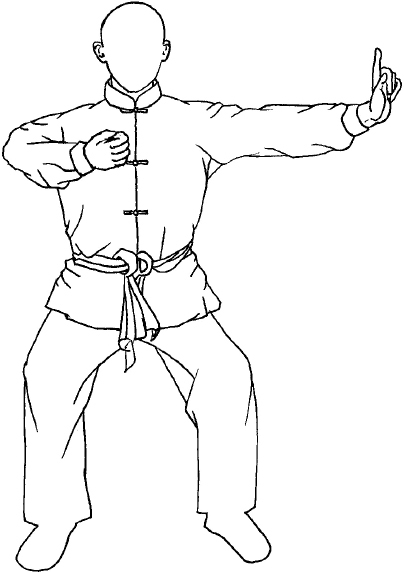
This routine can enrich the Essence and Blood, tranquilize the mind, and replenish abundant Essence to the Zang–Fu organs so that the five kinds of consumptive diseases and seven kinds of impairment can be removed.
Routine 5: Swinging the head and swinging the hip to relieve stress 
From the Natural Position, move the right foot to the right side with the feet apart. Raise the hands above the head, with the palms up and the fingers pointing toward each other. Slowly bend the knees to assume the Horse Stance, lower the arms, and press the hands onto the knee joints at the same time. Bend the elbows slightly with the outside of the little fingers facing outward. Raise the body slightly, move it to the right, and tilt the upper body to the right and forward, looking at the right foot (Swinging the head and swinging the hip to relieve stress). Swing the hip and shift the body weight to the left and move the upper body forward, and then turn to the left, looking at the left foot. Shift the body weight to the right to assume the Horse Stance. Repeat the above movements in the opposite direction. This routine should be repeated three-to-five times, and then return to the Natural Position.

This routine has a tranquilizing effect and is mainly used for neurasthenia and irritability. It can also improve the motor function of the waist and knees.
Routine 6: Touching the feet with both hands to strengthen the Kidneys and Waist 
From the Natural Position, raise the arms forward and then up above the head, with the elbow joints straight, the palms facing forward, and the fingers pointing upward. Bend the elbows and lower the hands to chest level, with the palms down and the fingers pointing toward each other. Turn the arms and move the hands to the back of the upper body from under the armpits. Move the hands along the sides of the spine to the hips, and bend the upper body forward at the same time. Continue to move the hands down along the back of the thighs and legs until they reach the arches of the feet, and raise the head (Touching the Feet with Both Hands to Strengthen the Kidneys and Waist). Move the palms forward along the floor and then raise the arms above the head and straighten the upper body. Repeat this routine six times and return to the Natural Position.
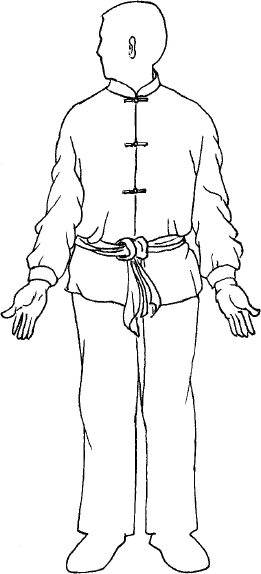
This routine is indicated in the treatment of lumbago. It promotes the smooth flow of the Q. of the Bladder Meridian and strengthens the defensive energy to protect the integument and musculature against external pathogens, thus preventing disease.
Routine 7: Clenching the fists with the eyes open for increasing strength 
Starting in the Natural Position, move the left foot one step to the left and bend the knees to adopt the Horse Stance. Clench the fists at the sides of the waist with the thumbs up. Slowly thrust the clenched left fist forward to shoulder level and look at the left fist (Clenching the fists with the eyes open for increasing strength). Turn the left arm inward; loosen the fingers and turn the left hand to allow the thumb to point down. Then clench the fingers to make a fist, slightly bend the elbow, and turn the fist facing up. Look at the left fist. Bend the elbow further to withdraw the fist to the side of the waist with the thumb side up. Repeat the above movements on the opposite side. This routine should be repeated three-to-five times; then return to the Natural Position.
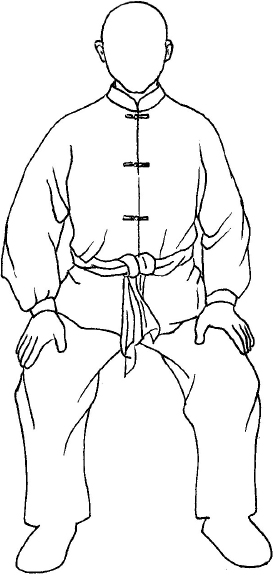
This routine is used for prevention and treatment of diseases of the neck, shoulder, and lumbar region, and also for increasing physical strength. It improves the power of the muscles in the chest, shoulders, arms, waist, back, legs, etc., and enhances their strength.
Routine 8: Raising and lowering the heels seven times to cure diseases 
Start with the Natural Position. Lift the heels and crane the neck; lower the heels to tap them on the floor (Raising and lowering the heels seven times to cure diseases). This routine should be repeated seven times, and then return to the Natural Position.
This routine will help regulate the meridians throughout the body and improve their function. When directing Q. downward by one’s will, blood pressure can also be reduced.
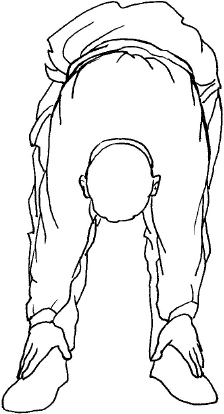
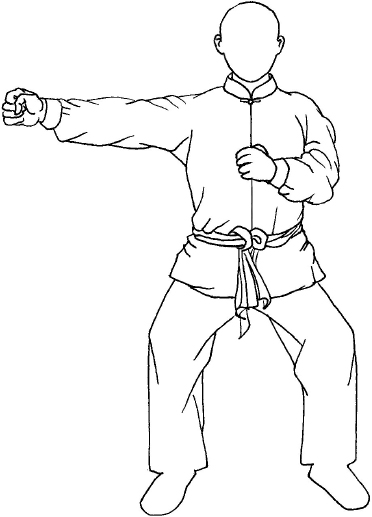

Summary
The above sections describe all eight routines of Ba Duan Ji. exercise. Remember that all movements should be relaxed, smooth, and graceful, and performed with natural breathing (i.e. not manipulating the breath). Deeper and longer breathing can be adopted at a later stage, after mastering the basic movements. Achieving and maintaining a calm and tranquil state is very important before, during, and after the practice. You should feel refreshed after practicing Ba Duan Jin. Beginners may find that they suffer from aching muscles and joints at the beginning, but by adopting the correct postures and continuing to practice, such symptoms will gradually disappear.

